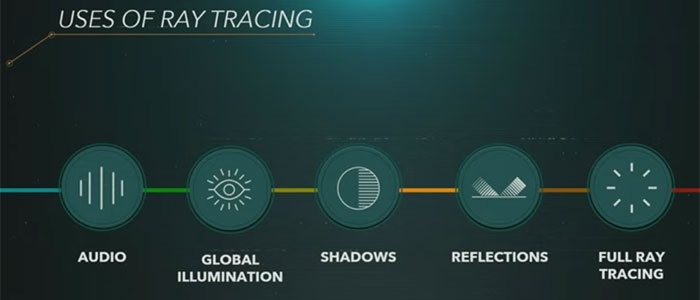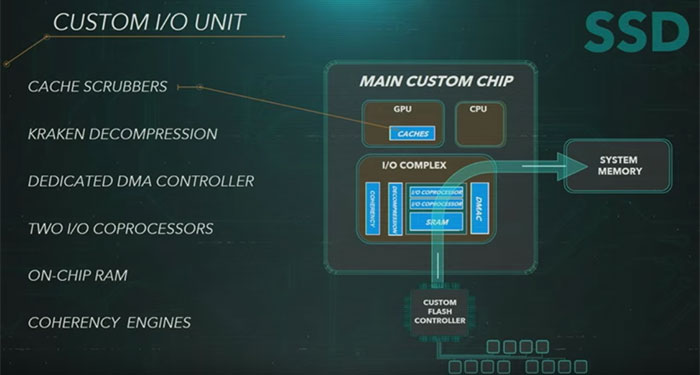Mark Cerny, lead system architect for both the PlayStation 4 and 5 has delivered a presentation about Sony's next generation games console. Like with the Xbox Series X reveal at the start of the week, ahead of the presentation Digital Foundry, part of Eurogamer, was provided detailed information on the upcoming console hardware and a pre-recorded copy of the presentation material.
One of the immediate questions many of you will have is about the Sony PS5's hardware specs and how they compare against its very recently revealed Microsoft Xbox Series X rival. I've compiled a comparison table below, trying to compare like with like as closely as is possible.
|
PlayStation 5 |
Xbox Series X |
|
|
CPU |
8x Zen 2 Cores at 3.5GHz (variable frequency) |
8x Zen 2 Cores at 3.8GHz (3.6GHz with SMT) |
|
GPU |
10.28 TFLOPs, 36CUs at 2.23GHz (variable frequency) |
12 TFLOPs, 52CUs at 1.825GHz, |
|
GPU Architecture |
Custom RDNA 2 |
Custom RDNA 2 |
|
Memory/Interface |
16GB GDDR6/256-bit |
16GB GDDR6/320-bit |
|
Memory Bandwidth |
448GB/s |
10GB at 560GB/s, 6GB at 336GB/s |
|
Internal Storage |
Custom 825GB SSD |
1TB Custom NVMe SSD |
|
IO Throughput |
5.5GB/s (Raw), Typical 8-9GB/s (Compressed) |
2.4GB/s (Raw), 4.8GB/s (Compressed) |
|
Expandable Storage |
NVMe SSD Slot |
1TB Expansion cards |
|
External Storage |
USB HDD Support |
USB 3.2 HDD Support |
|
Optical Drive |
4K UHD Blu-ray Drive |
4K UHD Blu-ray Drive |

The architecture of the PS5 is heavily dependent on a custom AMD APU, just like the new Xbox, however Sony's specs seem to fall a bit short of Microsoft's new hope in a couple of departments. In a particular insight into the decision making here, Cerny argued that faster RDNA 2 GPUs with fewer CUs deliver favourable performance for the system's target market as all the other GPU components can run much faster too. The PS5 will ably cope with cutting edge modern graphics with raytracing effects like reflections, ambient occlusion, shadows and global illumination, asserted Cerny. The system will aim to run games in 4K at up to 120fps. Also it is worth noting that the new system should be able to run nearly all of the PS4 games library without a hitch.

Most clearly in the Sony hardware's favour, at this stage, it seems to have looked more closely at the storage subsystem and you can see in the table above that it uses a so-called 'custom design' SSD, rather than an off the shelf PC component. Furthermore, the SSD communicates with the custom processor via extra hardware and software forming the custom I/O unit. The built-in storage can load 2GB of data into the console's memory in a quarter of a second, which is basically 'instant loading' according to Sony. As you can see in the above table, Sony's claimed 5.5GB/s transfer rates for raw data are greater than twice as fast as transfers within the Xbox Series X.

Another aspect of console design Sony seemed to concentrate on more than Microsoft was audio. Cerny revealed that the PS5 would use the Tempest Engine for audio processing. This processor is "effectively a re-engineered AMD GPU compute unit, stripped of its caches and relying solely on DMA transfers - just like a PS3 SPU," clarifies Digital Foundry. It is roughly about as powerful as "all eight Jaguar cores in the PS4 combined," boasted Cerny.
All in all it was a decently revealing presentation. It would be interesting to see Sony follow in Microsoft's footsteps to reveal the form of the new console and any new controller it has designed but it is still playing its cards close to its chest about consumer facing aspects of design such as this.
Both Sony and Microsoft aim to release their next gen console in the run up to Xmas this year.













